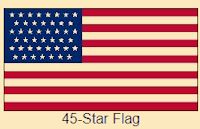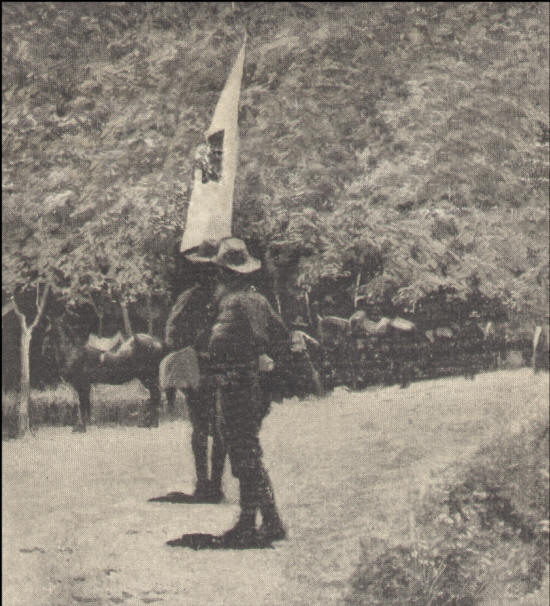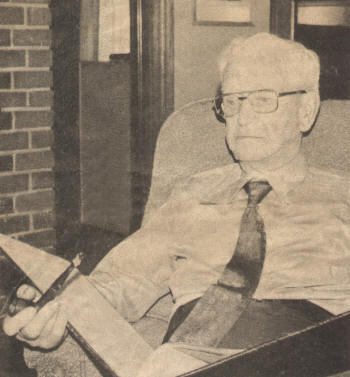Our Clark County, Wisconsin
SPANISH AMERICAN WAR VETERANS

3rd Wisconsin Infantry
William Campman Remembers the Maine in ‘98
By Lois Kieser, transcribed by Janet Schwarze.
William Campman
To get from the train depot at Hatfield to Neillsville, the 1879 traveler bumped
by wagon along the bank of the Black river; the 1896 graduating class of
Neillsville high school had five members; a football was a round object kicked
from one end of the playing field to the other; starting pay for a 10-hour shift
at the washboard factory was 50 cents a day; long journeys were made by train or
steamboat; and to go courting his best girl in style, the 1906 suitor hitched
his well-trained horse to a rubber tired buggy.
Facets of a bygone era penned with fading ink in yellow-paged ledgers and
journals’ For many persons, yes, but for William A. Campman, who will mark his
98th birthday on Monday, August 30, they are vivid memories of a busy,
productive lifetime.
His home on Clay street in Neillsville is filled with photos and memorabilia
gathered during nearly a century of experience. Among family pictures is an
early 1900’s print of two young women in a buggy drawn by a handsome horse—a
special horse named Gyp, trained to shift at a signal from a jiggly trot to a
smooth, swift pace. There are candid shots snapped on hunting and fishing trips,
too. And there is a heavy tablet cast from metal salvaged from the USS Maine,
together with muster rolls recording the names of the Neillsville men who
answered their country’s call to “Remember the Maine” in 1898.
The house, built by a returning Spanish-American war soldier on what was
considered to be the best street in Neillsville, has changed with the times over
the years. Gone are the long porches which greeted Mr. Campman and his bride of
several months, the former Helen Holmes, when they moved there in May of 1907.
For the first few months of their marriage, the couple lived upstairs above the
“Neillsville Times” in a frame building located where the telephone office is
nowadays.
The owner of the house has changed as well. A practicing attorney in Neillsville
for close to 70 years, and an active sportsman and golfer of note during that
time, he is now retired and limits his activities to less strenuous pastimes
such as reading and reminiscing. Except for some back trouble, his health is
generally good. By virtue of his age and keen memory, he is considered an
authority on local history and is sought out by those interested in the subject.
Their queries, he says, bring back many memories.
Moderation
The nonagenarian remains an inveterate pipe smoker and an interesting
conversationalist. As he approaches his 98th birthday, his counsel to those who
marvel at his great age is: Don’t over indulge in anything, and keep busy all
the time. At least, that’s the formula that’s worked for him. “Just good luck”
has had a lot to do with it, too, he says, and since longevity would not appear
to be an inherent characteristic of the Campman family, there’s no arguing that
statement.
William Campman was born in St. Louis on August 30, 1878, approximately one
month after the death of his father. Soon thereafter, his grandfather, Frank
Plischke, a builder and architect who had traveled about and found Neillsville
to his liking, wrote to his widowed daughter and urged her to come to
Neillsville with her young family. In 1879, the widow, her infant son and
two-year-old daughter, traveled up the Mississippi by steamboat as far as
Winona, then rode the Green Bay railroad to the Hatfield station. The remainder
of the journey was made by wagon along the west bank of the Black river.
The Widow Campman later remarried and four more children were added to the
family. They lived in a house on the east side of the city, near the standpipe.
William Campman attended Neillsville schools and graduated from high school in
1896 in a class of three young men and two young women. He graduated from the
law school of the University of Wisconsin in Madison in 1902 - but many things
happened to shape his life in the meantime
Busy Life
“Busy all the time,” is one way in which Mr. Campman describes himself. There
was no extra money in the family of six children, and so he put himself through
high school and law school. He began as a youngster to do odd jobs and chores
for neighbors, then later worked in the washboard factory located on what was
termed “Depot street,” across from the milk plant in Neillsville.
Business was booming in those pre-washing machine days, and the factory operated
on two, 10-hour day and night shifts. Mr. Campman began working for 50 cents a
day (or night), then was raised to 65 cents, and eventually earned a high wage
of 75 cents a day when he was put in charge of the steam engine providing power
for the plant. (He recalls that a specialty was a patented glass washboard
invented by one of the factory owners; the glass used was formed in St. Louis.)
Night School
It was fortunate that the demand for washboards merited a two-shift work
schedule, and that William Campman was curious about what a “typewriter” was and
what “shorthand” was all about. While he was working nights in the factory he
was able to attend shorthand and typing classes given during the day in a
downtown office building. Then, when he applied for a position at the law firm
of O’Neill and Marsh, his typing and shorthand ability helped him land the job.
Soon young Campman was Serving as Judge O’Neill’s court reporter, putting his
stenographic skills to work.
Apparently, Circuit Judge O’Neill was impressed by his reporter’s ability, and
wrote to the dean of the university law school about him. Shortly thereafter he
was enrolled in law school. In order to support himself, he took shorthand notes
of the law lectures, transcribed and duplicated them, and sold copies for $2 to
$3 apiece to other students. there was a ready market for the notes—education
was indeed proving to be a sound investment.
After graduation, Mr. Campman joined the Grow-Schuster company, a law office,
abstract firm and insurance agency. There were two Schusters in the company, J.
F. and his father, Herman who wanted to move to the West Coast. The young lawyer
took the elder Mr. Schuster’s place. Then, Charles F. Grow died in 1909 and the
firm became known as Schuster and Campman. J. F. Schuster died in 1946, and Mr.
Campman operated the business on his own until January 31 of 1972 when it was
sold.
Remembers the Maine
Displayed in his den and counted among his most valued possessions is a metal
tablet inscribed: “In Memoriam— U.S.S. Maine destroyed in Havana Harbor,
February 15, 1898.” The tablet also bears the information that it was cast from
metal recovered from the U.S.S. Maine, that it was cast in 1913 by a New York
bronze foundry, and that it is tablet No. 103. Mr. Campman has had it for 30 or
40 years and believes that it was sent to him by a congressman from LaCrosse,
since it was mailed from a congressional office in Washington, D.C.
The tablet has special meaning for him because, against his mother’s wishes but
with her reluctant permission, he was among other Neillsville men who went off
to duty in the Spanish-American was precipitated by the sinking of the Maine.
For a time he served as company clerk, and has duplicate original copies of the
company’s muster rolls.
The Neillsville company was mustered in at Camp Harvey at Milwaukee on May 11,
1898, and left by rail May 14 for Chickamauga Park, Tennessee, arriving at camp
there May 16. Company A, 3rd Inf., Wisconsin Volunteers, remained at-the
Tennessee camp until July 5, when the men marched to Ringgold, Ga., a distance
of 12 miles, and left by rail for Charleston, S.C., arriving there July 7. The
company embarked on a transport ship for Puerto Rico and arrived at Ponce on
July 28, 1898.
Covers County on Bike
The unit was commanded by Capt. John W. Hommel, who for many years was the
Neillsville police force. During the tour of duty, the company lost three of its
78 men, none in combat.
When hostilities ceased, the unit left for New York, again on a transport, on
October 22, 1898, arrived in that city on the 28th, and left for home by rail
that same date, arriving at the “home station” October 31.
Mr. Campman, having attained the rank of corporal, was mustered out on January
4, 1899. He is believed to be the state’s sole surviving Spanish-American war
veteran.
The Neillsville company included about 60 men when it first left for Camp
Harvey. More men were needed before embarking for Puerto Rico, and so Pvt.
Campman was detailed on recruiting duty and returned to Clark county for the
period of June 9-29. The young recruiter traveled over the dirt roads of the
county on a bicycle, protected from precipitation by a waterproof poncho
covering both rider and cycle. Looking back, Mr. Campman recalls that it was a
very warm, if effective, arrangement. There was no protection from dry weather
dust.
Among other recollections, he remembers that sports events have been popular in
Neillsville for many years.
As a young man, Mr. Campman was a member of the Neillsville baseball team and
has fond memories of gloving a line drive to first base and making a triple play
to save the game for the home team.
Another sport enjoyed by local youths was “football.” The Neillsville version
employed a round ball which was placed in the center of the playing field. Sides
were chosen - 10 or 15 players on each team - and the teams assembled on
opposite ends of the field. At the signal, team members ran helter-skelter for
the ball and everyone tried to kick it; there was no carrying or passing, as
hand contact with the ball was forbidden. When he attended the university, Mr.
Campman learned that there was another version of football.
Mr. Campman is a member of the United Church of Christ and has retained
membership in several Masonic orders. His interest in Masonry came originally
from his late partner, J. F. Schuster, who served as secretary of the local
Masonic lodge and was active in the construction of the Neillsville Masonic
temple.
He is also a member of an organization of Spanish-American war veterans.
Source: Clark Co. Press, August 26, 1976
I was an assistant to Capt. Hommel, who was commissioned to sign the truce and we went to sign the agreement in the field at Cayey. It was a nice pleasant meeting and after the thing was over we had dinner with Spanish. The meal was very good. It was much better than the food I was used to eating in the mess camp.
I was hiking down the road to Aibonito, trying to catch up with the rest of the troops who had gotten a two-hour head start on me. I had to stay and do some paper work in connection with the armistice. When I caught up with the troops, I noticed a little boy sitting all alone on top of a mule-drawn wagon. I tried to talk to him, but of course, I couldn't speak Spanish. Then I saw Hommel going into an official looking building on the east side of the road. I wondered why, and later I found out. The child, Placido Vazquez Ramos, had somehow managed to communicate to the American officer his desire to go to the United States with the troops. My commanding officer discovered that the boy's father was dead and had gone to ask the uncle's permission to take Vazques to the U.S. I drew up the adoption papers after becoming an attorney when I returned to Neillsville, Wisconsin.
William Arthur Campman
Source: The San Juan Star, pg. 2-Monday 4/8/74.

Signaling the Peace Message
from General Brooke's Position, August 13.
Related Links
Campman's History of the Spanish American War
Company A Muster Rolls, Original Documentation [Cover] [1] [2] [3] [4]
Spanish American War, Puerto Rico Campaign (Co. A, 3rd WI, which included many Clark County, WI soldiers)
Spanish Officers, stationed in Puerto Rico before the outbreak of the 1898 war posing in their fighting finery [Photo].
Obit: Campman, Helen (1886 – 1959)

